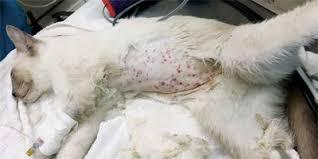Unraveling the Mystery of DIC: When Blood Clotting Goes Rogue
Disseminated intravascular coagulation (DIC)
A dangerous disease called disseminated intravascular coagulation (DIC) is marked by a blood clotting system that works too hard. When tiny blood clots start to form inside the blood vessels, all the parts that are needed for normal blood clotting are used up. In the end, the cat will bleed out of control, which can be fatal if they don't get care. DIC can be either short-term or long-term. Acute DIC gets worse faster and is more serious.
What is DIC?
In a healthy animal, blood proteins and special blood cells work together to keep blood clotting under tight control. When a blood vessel wall is broken, collagen can be seen in it. Platelets are a type of blood cell that is pulled to this collagen. Once the platelets close the hole in the wall, they release chemicals that mix with other things in the blood to make fibrin strands. These fibrin threads stick together to make a web that keeps platelets in place and makes a stable blood clot.
This clotting cascade is triggered in DIC by inflammation- or cancer-induced cell injury. The platelets and clotting proteins are depleted when tiny blood clots develop inside the blood arteries. This implies that in the event that blood vessels are destroyed, these will not be accessible when needed. Thus, ironically, the animal has a propensity for bleeding even though it has an overactive clotting system.
Small blood clots that form in the blood vessels of the liver and kidneys can hurt the liver and lead to breathing problems, nerve problems, kidney failure, stomach problems, and other organs not getting enough blood.

How would I know if my cat has DIC?
Since DIC is the result of an underlying illness, your pet may have shown symptoms of other illnesses, such as sadness or low appetite, or you may already be aware that your pet has cancer.
The non-specific symptoms of DIC, which frequently appear over a few days, can affect almost any organ. If there is bleeding, it may happen internally, so you might not detect it. In just 3 out of every 20 cats with DIC, bleeding may occur. Tiny bruises on the skin or gums may exist, but they may also be hard to spot in cats with dark skin and in places covered in fur. Nasal bleeds and bleeding at the gum line are additional common types of bleeding observed with DIC.
Deep vein thrombosis (DIC) cats often have bleeding that will not stop from any place where blood has been drawn. Some digestive signs that may include blood are throwing up and diarrhea. Damage to other organs, like kidney damage that makes it hard for your pet to urinate or blood clots that get stuck in the lungs and make it hard to breathe, are also signs.
How will my veterinarian know if my pet has DIC?
Before getting DIC, most people have had acute inflammation, injuries, or cancer in the past. It is strange and scary when major symptoms that affect many parts of the body show all of a sudden. If this happens along with signs of spontaneous bleeding, your vet may want to do some tests right away to find out what is going on. A blood sample can be taken to check for platelets and see how long it takes for the blood to clot.
Additional samples might need to be obtained to check for damage in other organs, and specialized imaging methods can be employed to check for clot-related damage in the kidneys or lungs, for example.
Why does my cat have DIC?
Damage to the body that causes the clotting system to overreact leads to the development of DIC. Hemangiosarcoma and lymphoma, two blood vessel malignancies, as well as metastatic breast tumors, have been linked to DIC. Numerous infectious diseases, including bacterial sepsis that results in panleukopenia, FeLV-associated infections, and inflammation linked to FIP, can also cause DIC.
There are also many other serious illnesses that could be at play, such as heat stroke, shock, autoimmune-mediated hemolytic anemia, snake bites, serious injuries, and surgeries. It is also possible to get inflammatory diseases like pancreatitis.
Can DIC be treated?
There are two parts to the treatment for DIC. The patient's main goal is to stay alive, and their secondary goal is to figure out what is going on and, if possible, fix it.
Clotting factors will be given through a blood or plasma transfer, but this is only a short-term fix because these will be quickly used up again if the DIC does not go away. Keeping the blood pressure steady is important to make sure that the organs get enough blood, and drinks can be given through an IV, especially if the patient is in shock. Extra medicines could be given to try to slow down the clotting responses.
Sadly, there is not much hope for animals suffering from DIC. The likelihood of recovery is extremely low unless an underlying reason can be found. In particular, if sepsis is suspected and a patient has the ability to calm down, antibiotics will be administered. Many of the disorders may be highly significant on their own, making treatment challenging even if the cause is found.
If you are worried about your pet's health in any way, please talk to your doctor. DIC is a very dangerous illness, but early evaluation and treatment have the best chance of working.


